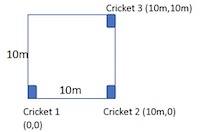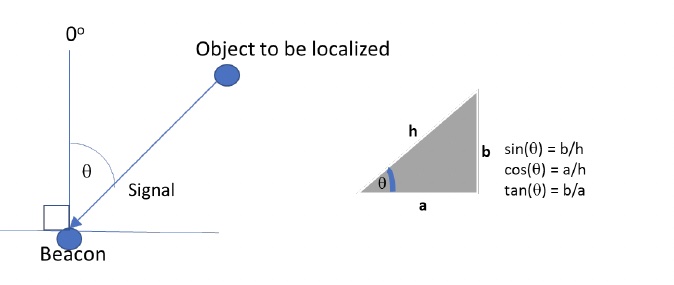
Wireless Networking aka “Wireless for IoT Class”
Course code: CS4222/CS5422
Semester 2, 2022/2023
Instructor: Professor Ambuj Varshney
Contact: ambujv@nus.edu.sg, COM3: #02-25
TUTORIAL 5 for WEEK 9 (Starting 6th March 2023)
[1] Question 1: The figure below shows a 2D square of 10m by 10m with three cricket nodes placed at different locations. The table below shows the wall clock time for the radio and audio signals from the node to be localized to reach each of the three cricket nodes. You can assume that the speed of light is 2x10^8 m/s and the speed of sound is 300m/s. You can also ignore the processing time. Your task is to estimate the (x,y) coordinates of the node to be localized in meters, using cricket 1 as the origin (0,0).

| Cricker 1 | Cricket 2 | Cricket 3 | |
|---|---|---|---|
| Radio | 1s | 1s | 1s |
| Audio | 1.028s | 1.020s | 1.020s |
[2] Question 2: Localization can also be done by measuring the angle of (signal) arrival. In the figure below, the signal angle of arrival is theta degree. The right figure provides reference for some basic trigonometric relationships.

Consider a 2-D plane with two beacons. Beacon 1 is located at (0,0) and beacon 2 at (10,0). Let the (unknown) position of the object to be localized be (X,Y). The angle of signal arrival from the object to Beacon 1 is 40 degree and the signal angle of arrival from object to Beacon 2 is 300 degree. Write down 2 equations that determines the unknown location (X,Y) and find the values of X and Y.
[3] Question 3: You are tasked to design an app that tracks the user’s location using GPS. The GPS sensor consumes 400mW of energy, while the accelerometer sensor consumes only 5mW. You know that the user is mostly stationary when using the app. How can you design an energy-efficient and accurate app that can track the user’s outdoor location? Explain your approach and its advantages.
[4] Question 4: The ALOHA and slotted ALOHA protocols have a maximum channel utilization of 18% and 36%, respectively. However, the CSMA/CA protocol can achieve much higher utilization. How does CSMA/CA do this? Explain the main difference between CSMA/CA and ALOHA protocols and how it affects the channel efficiency.